Grimsey Island - Iceland's northern gem
- Asha

- Sep 12, 2021
- 8 min read
Timeline: 23rd of July 2021 leaving Húsavík and arrival in Grimsey Island, 24th of July 2021 leaving Grimsey Island southbound for Raufarhöfn, Iceland's most northern port on the mainland.
The sail from Húsavík to Grimsey Island leads through waters famous for whale sightings, however our crossing was pretty uneventful in terms of such encounters. Few dolphin pods passed in the distance and one minke whale, or at least that's what we identified this animal as, teased us by showing its dorsal fin while swimming into the setting sun and away from our yacht. Unlike the marine mammals, birds are not camera shy and were floating on the surface of the sea. When we got too close, they would spread their wings just to glide a short distance away. Puffins resorted mainly to diving right down, and less often peddled their webbed feet in a concerted effort to take off and fly away. I thoroughly enjoy watching fulmars as they clap their webbed feet on surface of the sea, seemingly struggling to take off, just to land a few meters away from the bow of our boat and then try to fly again.
On the entrance to the port on Grimsey we passed two cruise ships at anchor, with tenders ferrying the holiday makers to and from the island, which is a paradise for bird watchers. The other touristy attraction is the crossing to the Arctic Circle. Winter season also offers spectacular Aurora Borealis, however we were few months too early, or indeed too late, to enjoy this attraction.
We arrived in Grimsey on the 23rd of July, late in the evening, and moored in the outer harbor along the concrete pier protected with tyres. Normally this place is reserved for the ferry connecting this northernmost inhabited point of Iceland with Akureyri, Iceland’s second largest city located on the north coast of the mainland. The ferry, however, wasn’t due for the next 48 hours, so the harbour master temporarily allocated this spot to us. The inner harbor was occupied by fishing boats, with the only free space reserved for the cruise ships’ shuttles.
The only settlement on Grimsey, village called Sandvík, is visible from the harbor. The harbor master pointed to us the local restaurant, named appropriately Krían (Icelandic term for Arctic Tern), and a grocery store which is open for one hour per day. Clearly, the populations of around 60 people does not require a shop open all day. Lucky shop keeper. Despite the island’s size reaches only 5.3 km2, it offers the local folks services like a school, a swimming pool and even an airport. Grimsey is also a home to Iceland's smallest Café, which is located at the Guesthouse Gullsól.
The road from the harbour climbs up and splits into two directions - one leading to the village and further around the south coast of the island, and the other to the cliffs on the west and north side of the island. Our first walk after arrival led to the western cliffs inhabited by puffins and other sea birds. On the way to the cliffs we kept getting attacked by ferocious arctic terns, who were nesting in the grass around the harbor and by their very nature are super protective of their territory. These birds repeatedly bomb dived at us, sometimes brushing off Mark's hair, but never really coming to full contact or doing any harm. Arctic terns make specific noises while attacking, which resemble clicking sounds. They are beautiful and graceful, with slender bodies, long split tails and relatively wide wingspan, and in their overall shape resemble swallows. In the air they are very swift and agile, and put up spectacular show when attacking an unwitting human being. It is advisable to carry a stick above one’s head, and not to bat these birds out of the sky, not that anyone would be ninja-fast and skillful enough to do that, but to avoid very close encounters.
No Arctic Terns or humas were harmed in our crossing further down the west coast of the island where we were drawn by massive colonies of puffins. We often encounter few puffins on the seas, but they quickly dive to escape the little fame we can offer by posting photos of them on social media. On the cliffs of Grimsey however they were sitting quietly, eying us gingerly, ready to fly away if we dare to come too close. One nervous puffin who takes off first always causes a domino effect as all the other puffins in the vicinity follow and the whole colony seeks shelter by landing on the water. These birds, except for being a tourist attraction, are a local delicacy so no wonder they are always eager to escap - fame or cooking pot, but a puffin can never know which one it is, so better be safe than sorry.
We walked down a coastal road until we reached "Orbis et Globus", a concrete globe which marks the current location of the Arctic Circle in Grímsey Island. It has been placed there in the fall of 2017. It is a 3-meter sphere, which is meant to be moved around the north end of the island in accordance with the movement of the Arctic Circle. Before the 2018 Summer Solstice Festival in Grímsey, "Orbis et Globus" was moved about 130 meters to the south. This land mark attracts a lot of tourist and visitors that come to the island aim to reach "the sphere of the north", which provides a palpable proof that they have crossed into the Arctic Circle.
The walk around the south-west coast leads to the lighthouse at the islands southernmost point and walk along magnificent basalt columns and old fishing huts, as well as the "Century stones" which display the position of the arctic circle in years 1717, 1817 and 1917.
Grimsey Island has acquired a reputation for being a chess-playing bastion. On learning this, Willard Fiske (1831-1904), American scholar and keen chess player, took a protective interest in the island, supporting the local economy, sending supplies and bequeathing money in his will, however he never set his foot on the island.
The island used to be a home to Miðgarðakirkja, Iceland's northernmost church. This place of worship was dedicated to Ólafur the patron saint of the Nordic people. Miðgarðakirkja was built from driftwood in 1867 on a site near Miðgarðar farm but was moved, by its own length in 1932 due to fire hazard and, at the same time, a choir stall and portico with a steeple were added. The altar was painted by a local artist in 1878, and was a copy of a work by Leonardo da Vinci. It was granted conservation status on 1st January 1990, in accordance with the provisions of legislation on ancient buildings. Unfortunately, the church burned down completely a couple of months after our visit, late in the evening on the 21st of September 2021, which is a great loss to the local community.
Our short and sweet visit to the island lasted 24 hours and we departed on the spur of the moment decision as the weather forecast changed and had us exposed to unfavourable conditions, especially with the inability to shelter in the inner harbour. We started our journey back south by motoring off towards a familiar port of Raufarhöfn.

The entire coast of Grimsey Island is inhabited by colonies of cute puffins. The locals consider the birds a delicacy and hunt for them after the nesting season. We didn't explore the local cuisine so puffins were safe in our presence, but still flew away as soon as they saw us approaching, just to be sure, I guess, as a puffin on Grimsey can never know...

Fishing harbour on Grimsey and the village visible in the background.

Altor of Down moored on the jetty where the ferry from the mainland normally comes in every second day. We were allowed to tie the yacht there as the ferry was just after leaving. We stayed only one night so we didn't need to worry about moving the boat for the ferry.

Fishing harbour on the Grimsey Island.

Icelandic totem on Grimsey.


Fishing harbour on Grimsey Island. Altor moored in the first basin of the harbour.
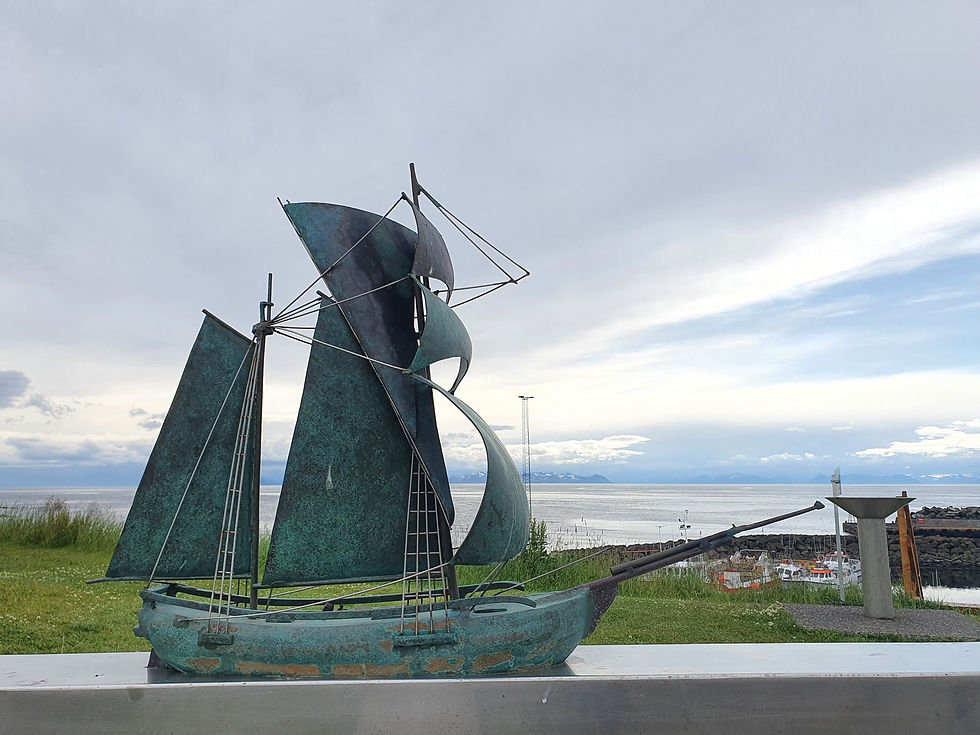
Grimsey Island - local art.

Willard is not your typical Icelandic name, like Sigurður, Haukur, Hilmar, or Þorgeir, however it does crop up on Grimsey.
The reason being an American writer, linguist, and chess fanatic Willard Fiske (1831–1904) heard that everyone on Grímsey played chess with the same passion as he played it, so he donated an expensive chess set to every family on the island. What’s more, he bequeathed $12,000 in his will to establish a library on Grímsey, thanks to which the grateful islanders began naming their children after him. The island’s library, thanks to the Fiske bequest, has a fine collection of old chess books.

Colony of puffins on the shores of Grimsey Island

Puffins and mainland Island visible in the background.

One can never have enough footage of puffins...

Beautiful shores of Grimsey Island.

Runway strip on Grimsey airport.

As I said, puffins are very endearing - I couldn't photograph them for a living.

Puffins, puffins, puffins....

...and more puffins...
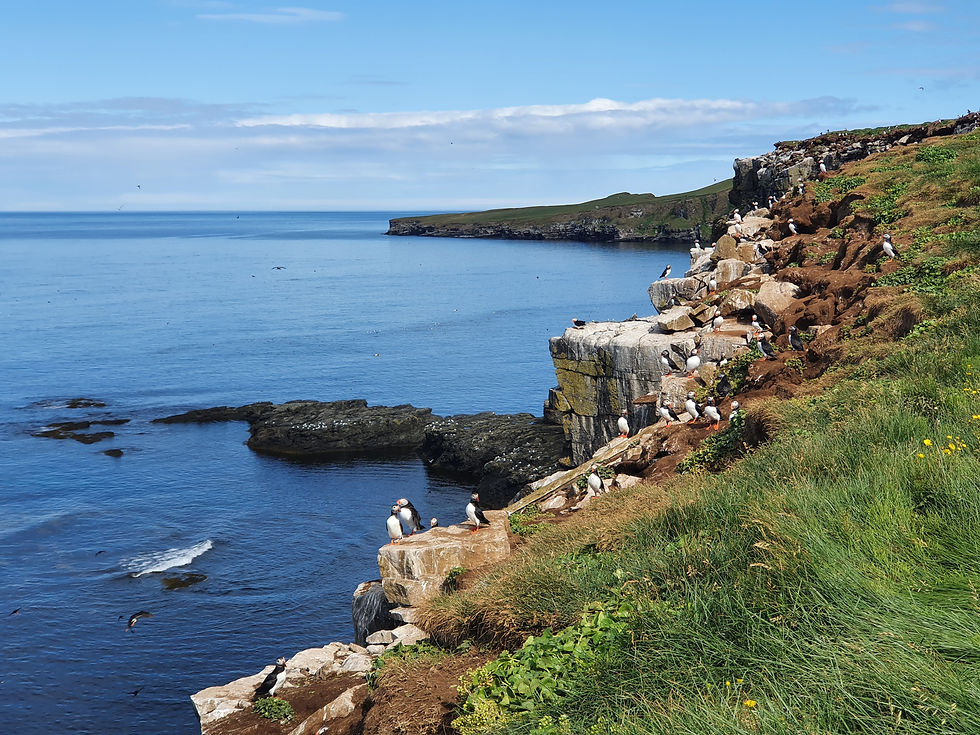
...and again!
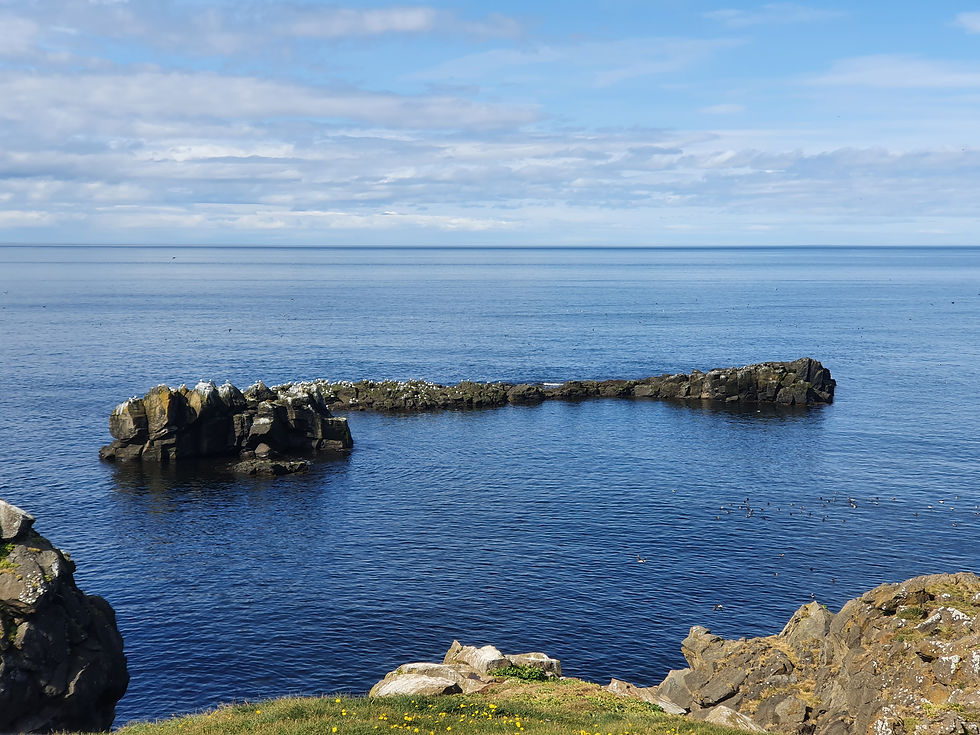
Every rock is covered wit bird colonies.

A lot of the colonies are... yes, you've guessed - PUFFINS!

Aren't they just so elegant in their black and white tuxedos and funky feet and beak?

Latitude and longitude displayed on a bench reveals that we are nearly in the Arctic Circle!

There are no trees on Grimsey Island, but there is plenty of grass. Judging by this machine, the grass is harvested and turned into hay for the sheep.

Grimsey is a fantastic destination for bird watches. The morning of our hike to the sphere marking the boarder of the Arctic Circle we met a lot of people equipped with very professional looking cameras and telescopic lenses who came to the island on the National Geographic cruise ship. Luckily they were on the way out while we were heading north so we had a fantastic opportunity to enjoy this special place on our own.

The Sphere that marks the current Arctic Circle's boarder.

Lighthouse on Grimsey.

Miðgarðar is the site of the northernmost church in Iceland. It was consecrated by Bishop Jón Ögmundsson in the early 11th century and was dedicated to Ólafur the patron saint of the Nordic people. At that time two clergymen served the church, and mass was sung daily and twice on holy days.
These services have dwindled but 50 clergymen have been recorded as serving the church over the years.
The vicar of Dalvík is now in charge of the church.
Miðgarðakirkja was built from driftwood in 1867 on a site near Miðgarðar farm but was moved, by its own length in 1932 due to fire hazard and, at the same time, a choir stall and portico with a steeple were added.
The church was extensively renovated in 1932 and reconsencrated in 1956.
The altar painting is by a local artist painted in 1878 and is a copy of a work by Leonardo da Vinci.
It was granted conservation status on 1st January 1990, in accordance with the provisions of legislation on ancient buildings.
The church was destroyed by fire late in the evening on the 21st of September 2021. No valuables could be saved from the church, which burned to ashes in only 20 minutes. Many valuable items got lost in the fire that cannot be compensated. The loss is enormous to the local community as the church has been a beautiful symbol of unification through generations for the people so far from the mainland.
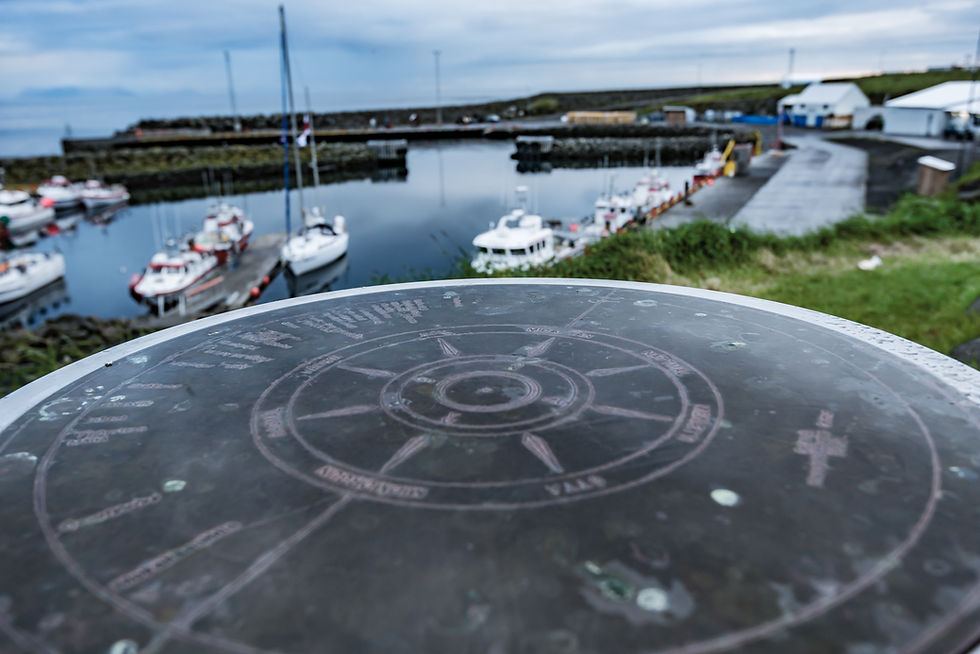

Altor moored in Grimsey harbour.
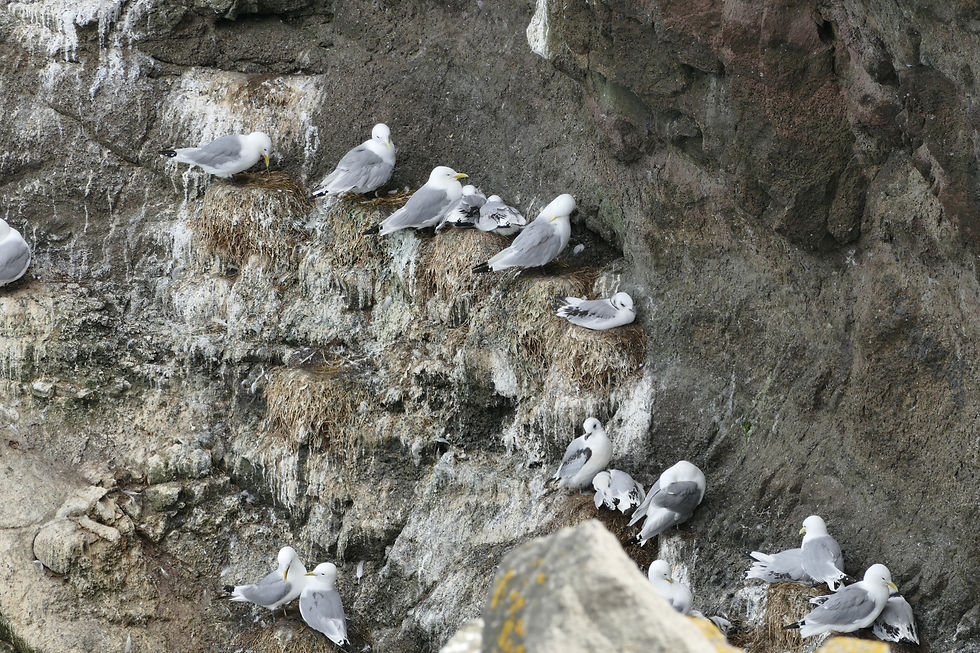
Birds nesting on sheer cliffs.

View from the north towards the Sphere.

Arctic Tern attacking the photographer from above.




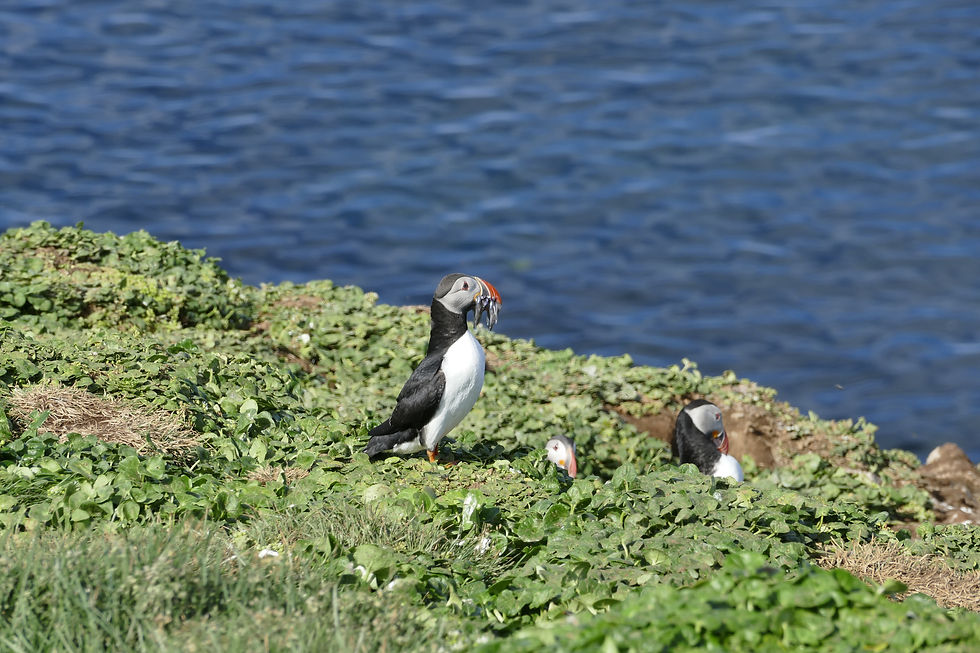








Comments